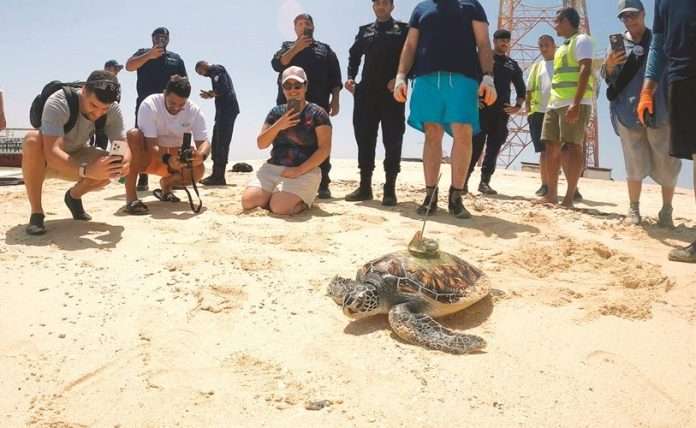The Deputy Director General for Technical Affairs at the Environment Public Authority, Dr. Abdullah Al-Zaidan announced the release of the third sea turtle last Monday as part of a project to study these creatures and preserve them from extinction.
Al-Zaidan said in a statement to Al-Anba that the authority, in cooperation with The Scientific Center, the Kuwait Foundation for the Advancement of Sciences and the Kuwait University, had initiated since last August the release of two turtles that were rehabilitated within the joint project and tracking devices were installed on them which showed that these turtles traveled more than 2,000 kilometers and one of them is currently on the western shores of India and the second on the southern coasts of the Kingdom of Saudi Arabia.
He announced that last Monday, the third turtle was released, which The Scientific Center rehabilitated and fitted it with the tracking devices.
He explained the aim of releasing these endangered turtles is to know their natural habitats and to know whether they will return to the country or whether they will find more suitable places to lay their eggs.
He pointed out that this study is jointly carried out with the Kuwait University in order to find out the appropriate climate of the islands for these turtles in which they usually breed and pointed out that the study of these endangered sea turtles, which are placed on the red list by the International Union for Conservation of Nature (IUCN), falls under the category of Kuwait’s commitment to play its local, regional and global role to implement what is stated in the international agreements that it has ratified, including the Convention on the Conservation of Biological Diversity and the Convention on Migratory Wildlife and will soon ratify the Convention on the Conservation of Migratory Species.
Al-Zaidan pointed out that turtles have existed for nearly two thousand years in Kuwait, and the ancient coins found on Failaka Island and the drawings on pots confirm their existence since the Dalmatian civilization.
He explained that many of the visitors of Qaruh Island do not realize that these turtles lay their nests from mo April to August and October, and the large number of visitors to the island during this period for long hours prevent these turtles from laying their eggs on the island, as the increase in human density on the island reduces the presence of nests.
He thanked all parties working with the commission to implement these projects to study the situation on the island, including the Coast Guard and its Director General, Major General Talal Al-Mounis, who facilitated access to secure the island, and the Kuwait Foundation for the Advancement of Sciences for the support it provides to fulfill Kuwait’s obligations, and The Scientific Center that is helping rehabilitate these organisms, and the University of Kuwait represented by Dr. Amani Al-Zaidan for providing scientific advice and necessary data and examining turtles and taking samples.
He pointed out that this cooperation allowed the establishment of the first database in the country for the migration of turtles and the DNA of these turtles will contribute to knowing if the offspring of these turtles will visit the Kuwaiti islands in the future.























